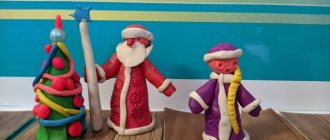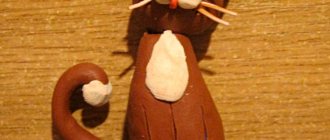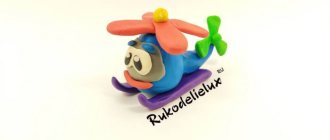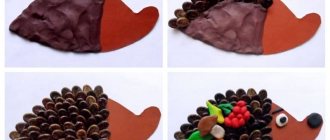Summary of a modeling lesson on the topic: “Bunny - long ears”
Program content:
1. Teach children to sculpt a hare from plasticine, conveying the characteristic features: the body is ovoid, the head is a modified ball, the legs are cylinders, the tail is a ball, the ears are flattened cylinders. Use color as desired. 2. Teach children in a combined way. Use the following techniques: roll out the plasticine with circular movements of your hands until you get a ball; roll out the ball with straight hand movements until you get an ovoid; roll out the plasticine with straight movements of your palms until you get cylinders; draw eyes in a stack; Carefully smooth out the joints. 3. Explain the execution of your actions: back and forth, straight movements, cultivate accuracy in work. 4. To instill in children a desire to sculpt, to finish what they have started, and to cultivate accuracy in their work.
Previous work
: modeling cylinders from plasticine with direct hand movements; balls with circular movements of the hands; ovoids, rolling out the balls with straight movements of the hands.
Individual work
: teaches Masha.S., Vanya.F.
do the work independently, without the help of a teacher. Material for the teacher:
bunny - toy, hares - option. Samples from plasticine of different colors; plasticine, board; napkin; stack
Materials for children: plasticine in a set, board /individual/, napkins, stacks.
Progress of the lesson.
The children are sitting at the table. I am reading poetry. Once upon a time there was a bunny with long ears. The bunny's nose froze at the edge of the forest. My nose froze, my tail froze, and I came to warm up and visit the kids. I carry a bunny toy. - Guys, look, a bunny has come to us. -What color is the bunny? What body parts does the hare have? (torso, head, ears, tail, paws). What does the head look like? What about the torso? What shape are the ears and paws? That's right, guys. Do you know why the bunny came to us? He got bored in the forest, he wants to find new bunnie friends. Well, guys, let's help him? Then today we will sculpt bunnies from plasticine. Look how I will do it. I have balls of different sizes prepared in advance: a large ball for the body, a medium one for the head and a small one for the tail. I also made cylinders for the paws and ears. I take a large ball and roll it with straight forward and backward movements of my arms until I get an ovoid. This is the torso. Now I take the middle ball and pull out the muzzle. And now I press the head to the body and smooth it at the junction. Then I take two cylinders and press them to the body - these are the paws, and I also smooth it. And now I take the stack and draw the eyes. So I got a bunny. Guys, where do we start? (Roll out the balls). Show how we roll out the ball (with circular movements of the palms). What about the cylinders? (straight arm movements back and forth). Now, children, take some plasticine and start working. I draw the children's attention to the variable patterns, to the fact that they are of different colors. I remind you how to roll out an ovoid. I distribute cardboard carrots to the children (carrots with the children’s names). -Guys, bring your bunnies to our guest and place them around him. Let him look at your work. Bunny is very happy to make new friends and thanks you. Well done children, everyone did their best. And now the bunny wants to play with you.
Game "Grey Bunny Washes His Face."
Techniques for making different plasticine bunnies
A plasticine bunny can be molded using various techniques. Children in different age groups of kindergarten sculpt bunnies from different types of material. Therefore, it is important to consider several techniques on how to sculpt a hare from plasticine.
Application for children of the younger group and beginners
For a plasticine hare figurine, which is sculpted by children from the younger group, you need to prepare a sheet of brown cardboard and plastic material: white and blue.
Step-by-step modeling of a hare from plasticine for children is presented as follows:
- First you need to make snow by mixing both colors together and, after kneading them thoroughly, apply them to the bottom of the cardboard, filling a certain space.
- From a white block you need to sculpt the parts of a bunny: head, torso, legs and tail. Apply them to the base, pressing lightly with your finger and palm.
- Use black plasticine or beads to make eyes and a nose for the bunny.
- Apply white pieces to a piece of cardboard to imitate snowflakes.
A simple application is ready. You can give it to a friend or decorate your room.
Simple three-dimensional hare crafts
We sculpt a hare from plasticine with the children of the middle group of kindergarten in different versions.
The white plasticine hare is made of two parts. First you need to sculpt the body from a thick oval-shaped piece. Then bend the upper part a little, and form paws on the lower part: press the dents on four sides with your fingers. Make an oval for the head, then draw out a nose from it.
Pull out the second part more strongly and use a stack (with a small knife, on the other side there may be a spatula) to divide it into two parts, these will be the ears. Make a hollow between the ears with a round pencil, and do the same with the outer parts of the ears. Make the inner surface of the ears and mouth from the pink mass. From black - eyes, glue them on the muzzle. Connect the torso and head. Roll a small white ball and place it in place of the tail.
This hare can be molded from light plasticine. There are few details in his figure; they are made quickly, without having time to dry. This bunny is made of airy plasticine and has practically no small parts that dry quickly, making it difficult to glue them together.
Bunny figurines combined with other materials
Crafts made from plasticine and other available materials are considered more complex. Children from 1st grade can cope with them, but with the help of their parents. The most popular materials at hand are paper, cardboard, tree leaves, spruce or pine cones.
Easter bunny made of plasticine on the lawn: a plasticine figurine is located on a green lawn made of cardboard and paper. In the photo - this is a pink version of a hare with Easter cake and Easter eggs:
A hare made of plasticine and a pine cone. The craft is very beautiful and interesting. It can be given to friends or loved ones. This is an excellent material to use and is easy to work with.
Detailed figurines of hares made of plasticine
Complex crafts are made from a large number of parts or from a more serious material, which is sculptural plasticine.
You can make a hare from sculptural plasticine in a simpler way in this way:
- First you need to make three blanks: the head, the torso and the lower part. Immediately give them the desired shape and connect them together using coating. You will get a general shape from which you need to form and sculpt the remaining elements of the animal.
- Make the front legs from flagella, attaching them to the body and giving them the desired position.
- The hind legs are made from thicker strands and attached to the lower part of the body.
- Make the ears from oval blanks and give them the desired position: they stand or hang, it’s up to the “sculptor”.
- Make the tail out of plasticine in the form of a ball and place it in place.
Using a sharp tool, detail the muzzle and chest, identifying the eyes and mouth, folds and fur on the chest.
Hare from the cartoon “Well, wait a minute!” This is a very popular craft in the older group of kindergarten. Both adults and children love him. How to make a hare, the diagram and sequence of actions is presented in the video.
You can sculpt a bunny figurine in different ways, using different tones of plastic material, using different methods. Plasticine crafts are distinguished by their diversity, originality and creative implementation.
How to work correctly
Children really enjoy working with this material. In addition, modeling teaches you to work with both hands at the same time, trains fine motor skills and creative imagination. To make a craft from plasticine, you need to learn the rules for sculpting small elements and working with different types of the material in question.
There are different types of plasticine: regular, wax, granular, fluorescent, with glitter. For kindergarten children, it is better to use the fluorescent variety, it is softer than usual. To make the material soft, it must be placed in a warm place or held in your hands.
There are the following techniques for working with this mass:
- rolling out;
- rolling;
- flattening;
- topping;
- pulling;
- smoothing out.
Having mastered them, you can create various figures.
There are basic shapes: a ball, a “cake” and a roller. You need to start working by cutting the block or pinching it off. After separating a piece of mass, you can begin to make various details of the craft. The ball needs to be rolled in a circular motion with your palms or done on a board. A “cake” should be made from a ball, squeezing it between your palms. It is necessary to connect the elements immediately, before the material has hardened, pressing down the parts and pressing them lightly.
To ensure that the small elements of the figurine are the same in size, you should cut even blanks from the new block. You need to roll up a roller from the already used material and then cut it into equal parts.








